

































he Spring season is one of my favorites — not just for the sunshine and blooming landscapes, but for the way our city comes alive with art, music, festivals, and sense of community. It’s as though the season brings a fresh energy, filled with vibrant creativity and a renewed sense of connection throughout Richardson.
Richardson is home to incredible talent and creative spaces, from neighborhood celebrations and live performances to inspiring art exhibits and passionate educators. That’s why we’re thrilled to dedicate this issue to Arts & Culture. We hope you discover something new and beautiful in these pages.
Speaking of new, this issue kicks off the newest addition to your beloved Richardson Life Magazine : Best of Richardson 2025! Nominations are open all month long and we invite you to celebrate your favorite local businesses, people, and places by casting your vote . It’s your chance to shine a light on what makes Richardson so special — and help elevate those who pour their hearts into serving this community.
So take a walk, soak up the season, enjoy some local art — and don’t forget to nominate your favorite Richardson businesses. Let’s continue to support and spotlight all that makes Richardson a truly remarkable place to live.
With gratitude, Kyla Obert

As editor of Richardson Life Magazine, I am privileged to meet so many people making a positive impact in our community. I am constantly impressed not only by the leaders of the City, but also by the quiet, servant-hearted folks. If you know someone who meets this description, you have until April 30 to nominate him or her to be a Richardson Real Hero and receive a coveted “Annie Award.”
A brainchild of Ann Eisemann, Richardson Real Heroes honors unsung heroes and promotes volunteerism in the community. For more than fourteen years, the Richardson Real Heroes program has “sought out outstanding individuals who go above and beyond, who unselfishly raise their hand when there is a need, who silently work to meet crucial needs
for multitudes of organizations in the city.” You can nominate someone by visiting their website at richardsonrealheroes.com
As Kyla mentioned, April’s RLM focuses on arts and culture. From the beautiful Crow Museum of Asian Art to ways in which art can be used as therapy to a pictorial celebration of the Chinese New Year, we bring you some of the best that Richardson has to offer.
Our Mover and Shaker this month is Beril Berk, Executive Director of the Dialogue Institute Dallas, based here in Richardson. For years, she has dedicated her time and energy to building bridges between cultures and people. Joining Beril on the pages of this issue are Andrea Davis, who founded Dallas Art Therapy, an organization which fosters mental and emotional well-being through art therapy, and Rozie DeloachZimmermann, an accomplished luthier whose life’s work revolves around helping musicians get matched to the perfect string instrument. Speaking of string instruments, Berkner High School’s Mariachi Orgullo has reasons to celebrate! Find out why in the RISD Educators’ Corner.
These and so many other fun people, places and organizations will hopefully fill you with inspiration and excitement. And you can celebrate what you love about Richardson by nominating your favorites in our Best of Richardson contest. The deadline to make your nominations on our website is April 30. And while you’re on your computer casting votes, remember to nominate a deserving volunteer for the Richardson Real Heroes honor.
As always, our advertisers make this magazine possible, so we hope you’ll keep your dollars local and support the awesome businesses you’ll find in the pages of RLM.
Enjoy!
Publisher Kyla Obert
Editor Patti Otte
Ad Sales
Mike Obert
Designer Open Look Business Solutions
Special Thanks
Janelle Teng, Toby Jones, Deborah Dobbs, Ally Haynes-Hamblen, Beril Berk, Rozie Deloach-Zimmermann, Amy Hofland, Caroline Kim, and Andrea Davis
Credit Image for Cover Page
Be the Inside of the Vase, 2012. Documentation of performance; photograph and video by Jamie Baker. Echo Morgan (Xie Rong) Chinese, born 1983; lives and works in the UK and China. Jamie Baker, British, born 1972; lives and works in the UK and China. Photograph and video courtesy of the artist duo, L2024.8.1-2
For Advertising Questions, please email mobert@hylogroup.com
For Editoral Requests, please email pmotte@hylogroup.com








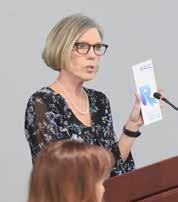





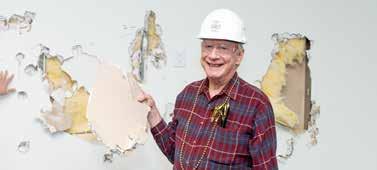
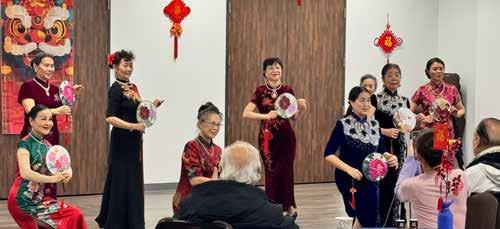
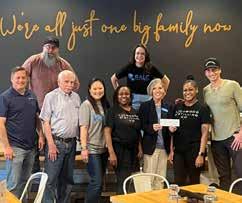







By Janelle Teng of Jeng Chi restaurant

Chinese New Year is also known as the Lunar New Year because the date of the celebration follows the lunar calendar. The origin of Chinese New Year celebrations can be dated as far back as 3,500 years. In addition to Chinese, m any Asian cultures celebrate the Lunar New Year, including Vietnamese, Malaysian, Taiwanese, Korean, and more.
The holiday is steeped in tradition and symbolism. Traditional lucky foods are included in banquet meals. Dumplings resemble Chinese ingot,
representing wealth and prosperity. In Mandarin the word fish sounds like ‘surplus.’ Preparing the whole fish and leaving some on the plate symbolizes having a surplus every year. The sweet rice balls, tang yuan, signify family togetherness. Vegetables such as lettuce and bok choy can symbolize wealth and luck. Fruit such as tangerines, oranges or mandarins, which are golden in color, symbolize fullness and wealth.
Chinese New Year festivities traditionally include a Lion Dance or


Dragon Dancing. The Lion is regarded as an auspicious animal and will dance to chase away the evil spirit. The Lion costume is often donned by two individuals with dance and acrobatic skills. A dragon dance is a large team that maneuvers a long puppet like dragon aloft. Long dragons are believed to bring good luck to the community.
Enjoy these beautiful images from our recent Chinese New Year celebration at Jeng Chi and in Richardson’s Chinatown.
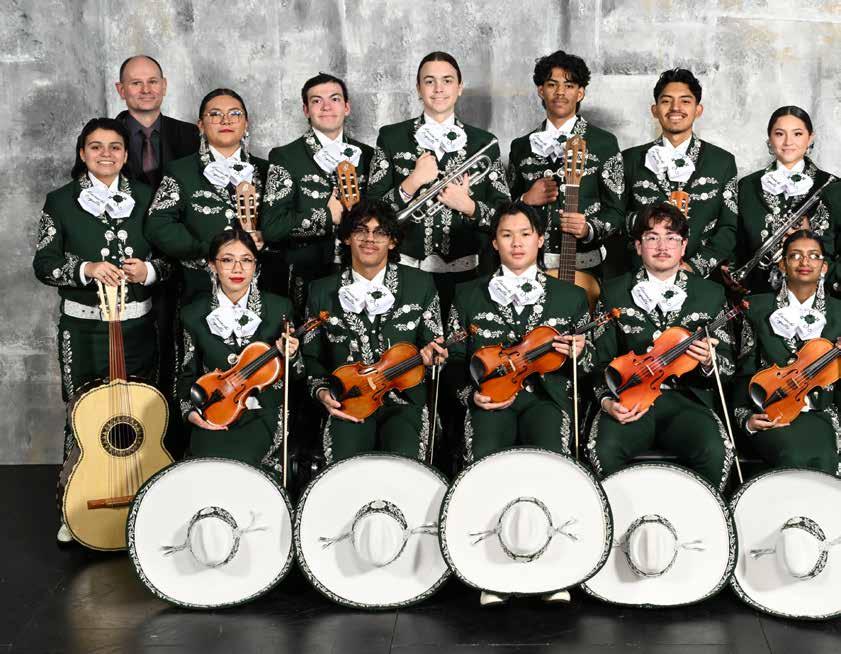

Please introduce our readers to the mariachi program at Berkner High School.
B erkner’s Mariachi Orgullo was formed in spring of 2022 as an afterschool program by Lydia Villarreal, the Orchestra director at the time. The following school year, Mariachi became a class.
You use the term Orgullo. What does it mean and how is it used?
O rgullo means pride or proud. Mariachi Orgullo and BHS Mariachi are both commonly used descriptors for
our ensemble. Mariachi Orgullo would be the name used when announcing the group. BHS Mariachi would be used in context around those that might not be familiar with what mariachi is.
How many members are in the BHS Mariachi?
We currently have 16 enrolled in the class with 30 actively participating in Mariachi at Berkner. However, preliminary enrollment numbers for next year indicate that we can expect to have more than 50 enrolled in Mariachi for 2025-2026. The word is out and the program has begun to recruit itself.
At which RISD events does the group typically perform? Do they perform at events other than at RISD?
M ariachi Orgullo’s first performance was at the first pep rally at Berkner HS, after which they received a thunderous review, resulting in a large number of students who wanted to join the group.
M ariachi Orgullo has performed more than 30 times for various events: pep rallies, assemblies, elementary celebrations, birthdays, restaurants, “promposals” and more. I get a call or email at least once a week with new requests.
What recent major competition did the group recently win?
M ariachi education in Texas has develop ed tremendously in the past 15 years alone. Band, orchestra, and choir UIL competitions have existed for several decades, whereas mariachi state UIL competitions have only existed since 2016.
T he 14 students from Mariachi Orgullo performed at the UIL Regional Mariachi Festival and earned a 1st division Superior rating. Considering the fact that four of the fourteen began learning the instrument they play just this year, it was an outstanding accomplishment. As a result of their performance, they advanced to the UIL State Mariachi Festival in Seguin, Texas. This competition marked the first time in RISD history for a mariachi to achieve
a superior UIL rating and advance to the state level.
Is this group the first of its kind in RISD? Whose idea was it to form the Mariachi?
To my knowledge, an attempt was made to start a mariachi program 10-15 years ago. RISD Schoolboard member Debbie Rentería has played a huge role in the idea of bringing mariachi to RISD.
What are the key instruments typically used in a mariachi ensemble?
M ariachi instruments include violin, trumpet, harp, guitarron, vihuela, guitar and guitarra de golpe. These instruments are grouped into one of two roles: the melodia or the armonia (melody and rhythm). The violin and trumpet make up the melodia section and all the other instruments make up the armonia.
Can you describe the role of the vocalist in a mariachi performance and how the voice interacts with the instruments?
I n a m ariachi ensemble, everyone sings at some point, whether they sing as a solo vocalist, harmonizing, or in a chorus. Part of our rehearsal every day involves vocal warmups and exercises for the entire group.
What are some common themes or stories told in traditional mariachi songs?
T he best way I can describe the richness in stories told in mariachi music is to briefly describe what
May 14, 2025
pm




Mariachi Orgullo performed at UIL. The first song performed was specifically written for Mariachi Orgullo to musically introduce the ensemble to the audience.
T he Mariachi Orgullo Tema lyrics with translation:
S panish
Ya llego, ya llego!
S u Mariachi Orgullo!
Tocando nuestra musica
Por las calles de mi tierra P a la gente mas linda y bella
English
We are here, we are here!
Your Mariachi Orgullo!
Playing our music,
Through the streets of my land
For the most beautiful people
T he second song they sang was “El Pueblo Nuevo” by Jose Hernandez, which shares the immense pride the singer has for his hometown. The third
song, “Perfidia” by Alberto Dominguez, has the singer lamenting over the betrayal of a lover that has left him.
How do different regions in Mexico influence the style and sound of mariachi music? Are there distinct variations in the music depending on where it’s performed?
I am not a mariachi historian in the least, but the more I have learned about the art, the more I have discovered that various mariachi styles are heavily influenced by and originate in certain regions in Mexico. One of the styles that we are required to play in competition is a “son jaliscience,” which is known to originate in Jalisco, Mexico.
M any other styles of mariachi music exist, much like there are styles of jazz: swing, rock, blues, fusion and more. Mariachi has the son, ranchero, bolero, and huapango, to name a few. All of these styles, like jazz, can be identified by the rhythmic patterns presented by the armonia.

What is the impact of having a mariachi program in your school and district?
I like to say that mariachi bridges all the performing arts together in one accord. We have the trumpets from the band, the violins from the orchestra, and the vocalists from the choir, along with the movement, choreography, expression and storytelling that comes from theater. And Berkner HS counselors have approached me in awe of how mariachi is engaging some of their students that otherwise may not have had the opportunity for such a positive high school experience.




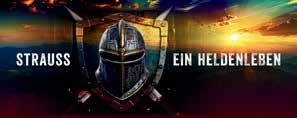


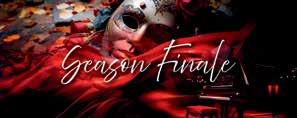




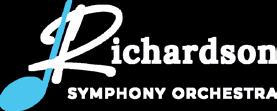

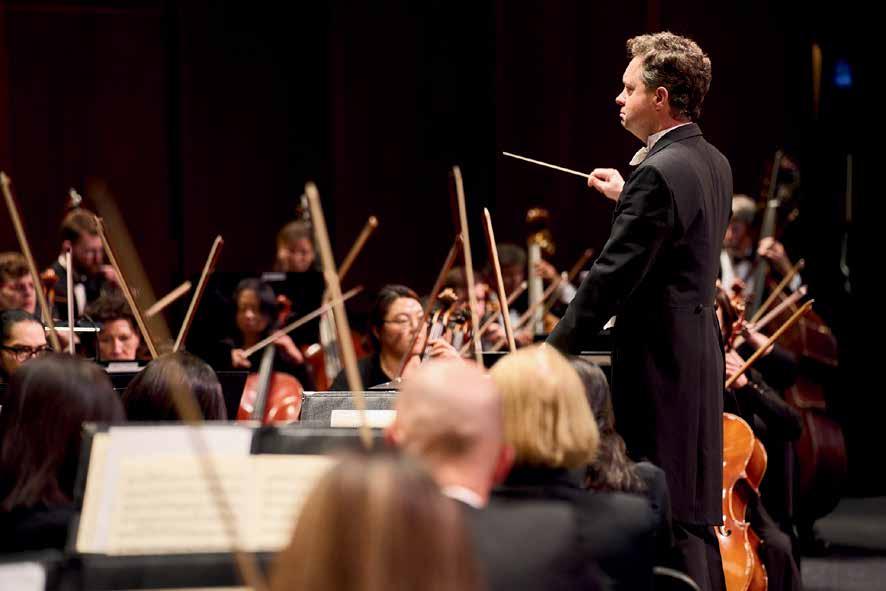


By Deborah Dobbs, MA

Can anything transcend language and geography better than art?
It's a cornerstone of human expression, a connector of people to their emotions, histories and communities. Art adds beauty to our surroundings, yet it also serves as a powerful salve for healing. Whether through painting, music, dance, or storytelling, art provides a means to process trauma, restore balance, and nurture the souls of people throughout the world.
In pre-modern Europe, folk art offered healing through shared creativity. In Ireland, through the sean-nós singing tradition—unaccompanied, emotive ballads—communities processed grief and hardship. With raw emotion and a trembling voice, a singer might share a tale of lost love or famine. Listeners would join in and, together, they would release sorrow. Collective mourning through song isn’t limited to old Irish
traditions. Other cultures have fostered (and continue to foster) resilience through song, turning pain into a communal strength.
For many cultures, particularly indigenous ones, art is inseparable from spirituality and healing. In Australian Aboriginal culture, for instance, dot paintings are deeply tied to stories of creation and link people to both

their ancestors and the land. These works are not just decorative; they are meditative acts that reinforce identity and belonging. Artistic expressions may become rituals to heal both the individual and the collective, mending rifts caused by displacement or loss.
EASTERN TRADITIONS:
ART AS MINDFUL PRACTICE
In East Asia, art often intertwines with philosophies that emphasize mindfulness and inner peace. I happen to love the metaphor of Japanese kintsugi, the art of repairing broken pottery with gold. The mended object represents resilience. It sends a clear message that flaws are not to be despaired and setbacks are often opportunities. The art of kintsugi fosters emotional well-being by reframing breakage or brokenness as beauty.
ART AS THERAPY
Because emotions and symptoms are sometimes too complex for words, art functions as a translator of sorts. Particularly in western cultures, art’s healing potential has been incorporated into modern therapeutic interventions. Art therapy emerged in the 20th century. Some mental health professionals earn certifications in this modality, while others use art to complement the therapeutic process.
Clients with PTSD might paint or sculpt their experiences, giving shape to memories that haunt them. Some clients with limited vocabulary can
use art to express their thoughts and feelings. Children can strengthen their emotional vocabulary by using colors to stand for the feelings they cannot yet name. After a traumatic event, they might also find it easier to draw what happened than talk about it. Clients of all ages, however, can find it easier
to share their thoughts and feelings during a session while engaging in art. Merely coloring in a coloring book can put a client at ease. In mental health, it seems the value of art is immeasurable.
ART’S ADAPTIVE POWER
Whether its soulful singing or sketching stick figures, art heals by meeting people where they are. The brush or crayon, the canvas or coloring book, the clay, dirt, or ink doesn’t care about your age, talent, or native tongue. It surrenders to you, reflecting pain or hope, and it becomes a bridge that connects the tangible to the intangible. Studies show that the act of creating lowers cortisol levels and boosts dopamine, reminding us that healing need not always come from a pill or a procedure. Sometimes, healing and well-being flows from a brushstroke, a melody, or a dance step.














Tell us about yourself and what first sparked your interest in the arts.
I grew up in Denver, Colorado, in a family of artists, so my interest in the arts was from birth, essentially. I earned my bachelor’s degree in theater from the University of Denver and after graduation moved to the east coast to start working professionally. While I landed a few performing gigs here and there, I was paying my bills by working behind the scenes in costume shops, prop shops, and stage managing, and I naturally gravitated towards the management side of the business. I learned early on that I have a brain for numbers as well as arts. I started in the for-profit commercial theater world, then moved into nonprofit performing arts, and now I work in the municipal side of arts management.
What was it about the Eisemann Center that made you want to work there?
It’s the people! I have worked with a lot of great people throughout my career, and I have to say that the Eisemann Center team is one of the best there is – truly dedicated professionals who care about the arts, and our community, and have a deep love for what we do here and what the Eisemann Center represents to the City of Richardson.
It’s really inspiring and I’m so grateful that I get to be part of this team. Richardson is a vibrant community— how do you make sure the events at the Eisemann Center appeal to a wide range of people?
Great question! As a newcomer to Richardson, and Texas, I have been spending a lot of time exploring the community, attending events throughout North Texas, and participating in programs such as Leadership Richardson to meet as many folks as possible, and learn about our area. At the same time, I’ve done a deep dive into the history of the Eisemann Center and the programs that have been presented here, as well as a comprehensive analysis of our patron base to learn who is coming to the Eisemann Center, and what they are coming to see. This gave me a great start to engage with parts of our community that I didn’t see as prevalent in our history, to ensure that the Eisemann Center is accessible to everyone.
How do you think the arts scene in Richardson can continue to grow, and how do you see the Eisemann Center playing a role in that growth?
The arts are so vibrant in Richardson, which is a big part of what makes Richardson so special. I would love to








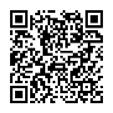
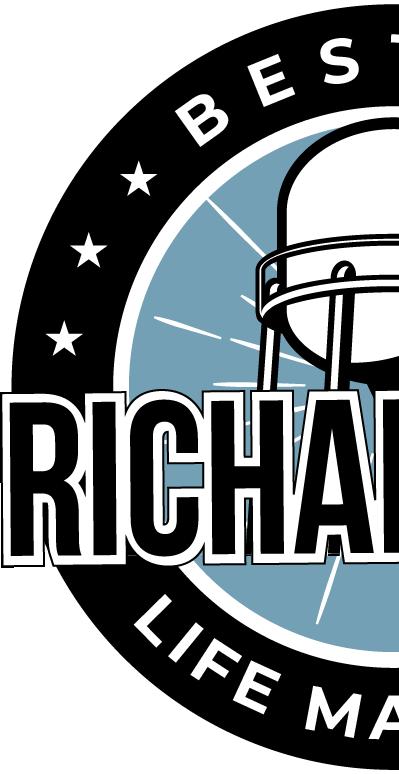

• Nomination Period (April 1 – April 30, 2025):
• This is your chance to nominate your favorite local businesses, people, and places in Richardson.
• Nominations are write-ins only.
• You can nominate once per day, per category, by visiting the Best of Richardson.
• Nominee Selection:
• After the nomination period closes, the top three nominees in each category will advance to the voting round.
• These nominees are determined by the highest number of write-in nominations received.
• Voting Period (June 1 – June 30, 2025):
• Now, it’s time to vote for the finalists!
• Visit Best of Richardson to cast your votes.
• You can vote once per day, per category.
• Winners Announced:
• Winners of the Best of Richardson 2025 will be featured in the August 2025 issue of Richardson Life Magazine.
• Winners will also be revealed in late August online, once the magazine reaches homes.

Pastor Clayton Oliphint with Beril Berk at the Dialogue Institute's interfaith Ramadan dinner at FUMCR
dialogue events, and cultural exchanges where people can connect on a personal level.”
An alumnus of Leadership Richardson Class 38, Berk also serves on the Board of Network, the Richardson Police Academy Advisory Board, and is an active member of the Richardson Chamber’s Women in
Leadership Committee. She says, “The Richardson Interfaith Alliance and civic organizations such as Richardson Chamber of Commerce play a crucial role in bringing diverse groups together.” She notes that schools, workplaces, nonprofit organizations and religious institutions who offer programs to teach cultural competency
help individuals better understand and appreciate different perspectives.
“The City of Richardson has been incredibly supportive in fostering a culture of inclusivity and engagement. Through its leadership, various community initiatives, and partnerships with organizations like The Dialogue Institute Dallas, Richardson has created

an environment where dialogue and collaboration can truly thrive,” Berk reflects.
While Berk was preparing for the bar exam in the U.S., she first became involved with Richardson’s Dialogue Institute as a volunteer. “The alignment of the organization’s mission with my values, aims and perspectives led me to take on a greater role as the Executive Director. It has been a rewarding journey, allowing me to continue fostering understanding and connection among communities,” states Berk.
The Dialogue Institute’s key initiatives include activities ranging from an annual art contest for high school and college students to a First Responders appreciation dinner. They also co-host
Interfaith Ramadan Dinners at various places such as houses of worship, hospitals, police departments during Ramadan every year in an effort to create cross-cultural connections.
Another exciting collaboration occurs at the Dialogue Institute’s Community Connect events, at which community members can learn about Richardson’s nonprofit organizations and volunteer opportunities. And the annual International Women’s Day Dinner and Panel is another one of the group’s signature events, during which distinguished women in their fields join the Dialogue Institute for a panel and dinner.
States Berk, “The most fulfilling aspect is witnessing the transformation that happens when people connect beyond surface-level differences. When a person’s perception of another culture or faith shifts from assumption
to understanding, it creates lasting friendships and strengthens community bonds. Seeing these bridges being built is truly rewarding.”
Berk is quick to emphasize that none of the work she leads at the Dialogue Institute would be possible without the dedication and generosity of volunteers, local friends, and community partners. States Berk, “Some of our local friends have been attending and volunteering at our events for years and their ongoing support has been instrumental in making our programs successful.”
In addition to the City’s support of the Dialogue Institute, Berk is quick to praise the City’s Leadership Richardson program. States Berk, “Leadership Richardson Class 38 was one of the best experiences I've ever had in my life. I truly enjoyed learning about how
Beril is such an incredible asset to Richardson and North Texas as a whole. Her service and work ethic are unmatched…a true professional with a heart of gold. I’ve had the honor to work with her both as a Councilman and as a member of FUMCR, which has hosted a couple of Ramadan Iftar dinners. Beril works tirelessly to establish lasting relationships and builds bridges on behalf of The Dialogue Institute. Her community at The Dialogue Institute and all of Richardson are both a better place because of her commitment and dedication.”
— Richardson City Council Member Dan Barrios
the City works together with all its institutions and how they collaborate on a regional level.”
She goes on to say, “Besides, one of the best parts [of LR38] was coming together with professionals who were all best in their areas, networking with them and learning from each other. For everyone who likes to be social and engage with the local community, I strongly suggest participating in the program. It's also a great opportunity to introduce your organization or your work to a wider community.”
Berk is also very involved in Compassionate DFW. A part of the global Charter for Compassion movement, the organization is dedicated to promoting compassionate actions in communities. Says Berk, “As board members, we work on initiatives that encourage civic engagement, social justice, and interfaith cooperation. In Richardson, we collaborate with local organizations to support underserved communities, promote understanding, and create initiatives that bring people together for meaningful conversations and service projects.”
Both the Dialogue Institute and Compassion DFW intersect in their mission-based focus, according to Berk. They both have community-
based projects, volunteer initiatives, and collaborative events, all aimed at strengthening connections and building a more unified, understanding, and service-oriented society.
Berk believes in the power of patience and persistence. She reflects, “Meaningful change takes time; even in the face of challenges, it is important to stay committed to fostering understanding and building bridges. If we don’t actively engage in creating positive connections, we risk leaving space for division and misunderstanding. That’s why I believe in continuing the work, no matter how small the steps may seem—because every effort contributes to a stronger, more inclusive community and eventually a world where our children and their families can live in peace and harmony.”
Berk has dedicated her life to serving others and credits her family for being tremendously supportive of her work on all fronts. She and husband Yusuf Ziya have two sons, Yusuf (Joseph in English) and Yunus (Jonah). Berk endeavors to balance her work as an attorney, a civic leader, a wife and mom with finding time to pursue her own interests. A lifelong learner, Berk enjoys discovering a new dish, new handicraft,
a new belief, a new place…and the meanings and traditions behind each one of them. She also enjoys writing and would love to have a travel blog, be a travel writer and have a publishing company if she had all the time in the world.
She also likes travelling and seeing new places, spending time with family, trying new cuisines at home, and watching figure skating at the Olympics. When she’s not working or volunteering, friends might spot Berk having a Turkish latte at her favorite hot spot, La Casita Bakery Shop, or attending a performance or cultural event at the Eisemann Center. Regardless of where she is, Beril Berk’s light shines brightly.








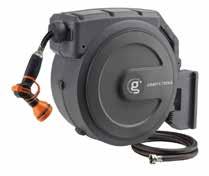


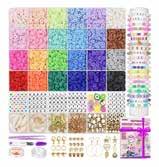
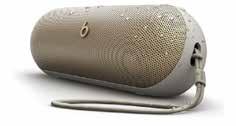
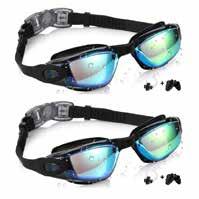

Scan this QR code to easily shop these products!

Tell us about yourself and Caraway Strings.
My family has been involved in the orchestra world since before I was born: my mother was a public school orchestra teacher and my father started a separate instrument rental business in the Arlington area, in his later years. Caraway is my maiden name, so the business name is a way of honoring my family heritage. Twenty-two years later, my mother is retired and my father has passed, so it brings me joy that the Caraway name is still helping the orchestra community in DFW.
You are a luthier, which is your business’s specialty. Can you tell us more about the luthier business?
A luthier is a fancy name for a violin mechanic. In its most technical sense, it applies to the repair and making of stringed instruments, so a guitar technician can also call themself a luthier. Fellow luthier Duncan Beaver and I focus on stringed orchestra instruments and we divide the work between us. We do everything from minor adjustments, bow rehairs, crack repairs, and even larger restorations involving taking the instruments apart and repairing from the inside.
What inspired you to start Caraway Strings, and how did you get involved in the string instrument world?
The twenty-four-year-old version of me was excited about the possibility of creating my own business while also being involved with music. I started out of my house, renting instruments to kids in the local school programs, and got hooked. Being involved in the

process of helping a kid develop his or her musical ability is fantastic. Over the years, I really fell in love with the technical side of instruments. Playing wasn’t very satisfying to me, but making a violin sound its best for a musician held meaning for me. My work moved more and more toward the workbench, learning good setup and repair.
What skills do you find most necessary for running Caraway Strings?
Being particular! Violins are particular. They get open seams in the dry winter, the pegs slip when the seasons change, bow hair literally changes length with the humidity, sound posts fall down, bridges wear out. We have to be particular in kind to get an instrument that performs its best. And we must be particular about communicating clearly
to our clients and our team. Clients need to understand what’s going on and our team needs to be certain problems are solved their best.
How would you describe the experience of working with your customers? What do you love most about helping musicians find their perfect instrument?
Helping a musician find their instrument truly is a matchmaking process. A player with an aggressive style will need a different instrument and setup than one who prefers a more melodic style and a young player will need a different instrument than a professional. The actual size of the person matters as well: everyone has unique arm lengths, which can affect how a bow’s balance point works for the individual, which affects how they are able to perform with that bow.
When a musician is shopping for his or her first nice instrument—perhaps they’ve been renting for a few years and need to graduate to something nicer—this is one of my favorite moments because I get to educate the musician on the different available options. Helping a musician spot sound differences in older versus newer instruments, trying out both wood and synthetic bows…it’s great helping that first-time buyer feel comfortable in a showroom setting and being guided to the ideal instrument.
All instruments benefit from a proper setup, perfecting both playability and sound, a process which I truly enjoy. This process includes cutting a bridge to the right height and thickness, making sure the strings are the right height over

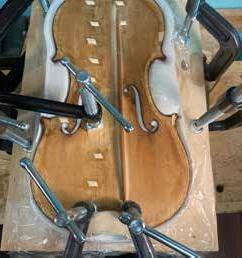
the fingerboard, getting the soundpost in the right spot, and dozens of other things. I love putting the instrument back in the player’s hands after making an adjustment or repair and seeing a delighted reaction.
What is your background? Have you always been an entrepreneur?
I had a desk job for about a year out of college and then started this venture!
It’s just about all I know. In my younger years, I was always labeled as creative, so I was driven to be involved in the arts in some way.
Do you have a motto or inspiration which drives your business and your life?
Because we serve a wide range of musicians—from the five-yearold renting a 1/8 size violin to the professional searching for a performance instrument—we keep going back to the word “matchmaking” here: the right service for the right person.
Do you live in Richardson? If so, what brought you here?
I have lived in the Richardson area since 2004 and my daughter is an RISD student. I’d like to add that it’s been wonderful supporting RISD teachers through the years and having them, likewise, support my business. I’ve been to every public school building in Richardson and work with the orchestra teachers regularly. To everyone reading
this, thank you for supporting public schools and the arts.
What advice would you give to other women considering starting their own business in a niche industry like this?
Specifically, in the lutherie industry, there’s never been a better time to be a woman! The Women in Lutherie group is a strong international community that looks out for one another, from giving business advice to making sure other women accept jobs where their expertise and opinions are valued. There are more woman-owned violin shops across the US than ever before. This industry was much more of a “boys’ club” even twenty years ago, but those days are dying.
My word of caution for this business is that it really does take a toll on the body over time. Making and restoring is actual labor, so potential luthiers must be prepared for this eventuality and take preventative measures.
Are there any exciting projects, collaborations, or new services you’re working on that you can share with us?
We recently did an overhaul on our operations in the shop: going paperless for contracts and billing, offering a texting service to clients, and digital archival note-keeping for client repairs. Our goal is to make the experience at Caraway Strings as easy as possible to as many people as possible.
How do you engage with the Richardson community and the wider Dallas area to promote the business and build relationships with local musicians?
Honestly, we rely mostly on word of mouth. Yes, we do school trips for teacher repairs and yes, we support some local orchestras with program ads. However, if musicians trust that you can take care of their instrument, which is in many ways an extension of them, they won’t go anywhere else and they will tell their friends. We’ve built our business on that trust.
For more information about Rozie or Caraway Strings, visit carawaystrings. com or follow them on Instagram @carawaystrings.
By Caroline Kim, Development Director
On September 24, 2024, The University of Texas at Dallas cut the ribbon to the long-anticipated first building of the Edith and Peter O’Donnell Jr. Athenaeum, a multi-phase arts and performance complex for the UT Dallas campus.
Since opening just a few short months ago, the museum building has welcomed more than 10,000 visitors from the UTD campus, the community, and beyond to visit the galleries, participate in tours and programs, and attend events. Dubbed the “Phase I Building” of the O’Donnell
Athenaeum, it houses the second location for the Crow Museum of Asian Art (its original flagship location in the Dallas Arts District remains open and active), the Brettell Reading Room, a seminar room, conservation studio, and five additional galleries dedicated to the
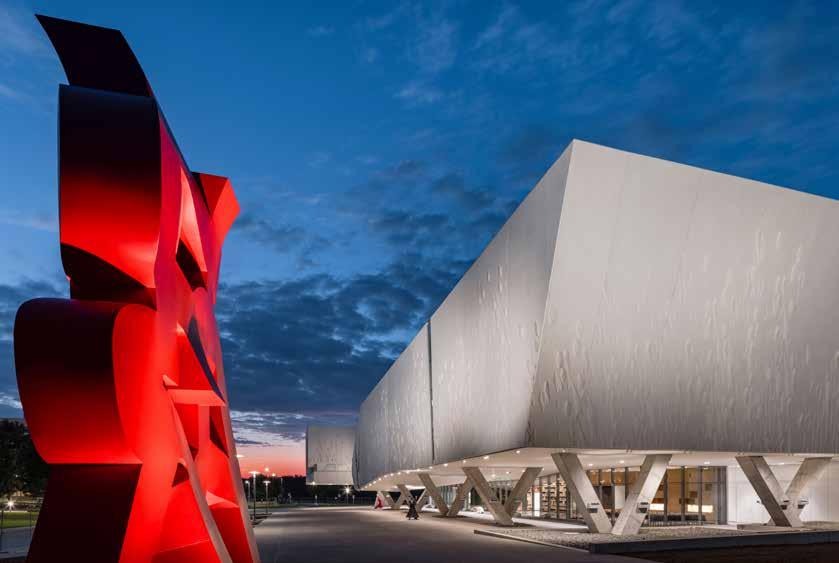


University’s growing art collection and interactive partnerships.
Though primarily known for its stellar academics in STEM-related fields and research, UT Dallas has a long history of supporting and nurturing the arts. It was this demonstrated commitment that attracted the Crow family when considering its long-term plans for the collection.
In 2019, the Crow family donated its entire collection of more than 1,100 objects to the university for its continued care, preservation, research, and engagement. In the same spirit of their original gift to the Dallas metroplex with the opening of the free downtown museum in 1998, the Crow family began a new chapter of their legacy with gifts of objects and support toward building the first phase of the O’Donnell Athenaeum. To ensure as much access as possible, the University followed the family’s lead by also making the campus museum free to all visitors.
Programs, art workshops, artist lectures, community events, and more are in the works for neighborhood
engagement. K-12 school tours for Richardson ISD and neighboring districts are led by university student docents who have undergone more than 50 hours of training. The membership program offers more enhanced and deeper access and connection. Plus, community ideas and partnerships are always welcome.
SAYA WOOLFALK: FLOATING WORLD OF THE CLOUD QUILT
The Crow Museum is pleased to present Brooklyn-based artist Saya Woolfalk’s first Dallas exhibition in the multimedia gallery. Over the span of twenty years, Woolfalk has undertaken the project of world-building she has named the Empathic Universe. Through this techno-genetic perspective, visitors engage in an alternative mode of “being” in which the Empathics, as a lived-in community, invite visitors to center the emotions of compassion, empathy, and love.
For this immersive installation of Cloud Quilt, Woolfalk created a dynamic interplay of symbols and imagery by
Enter “Edith and Peter O’Donnell Jr. Athenaeum” into Google Maps to direct you straight to the Lot M East parking lot.
Parking in the purple and orange spaces in Lot M East are free on the weekends; white metered spaces are always available through the PayByPhone app or by phone.
Tuesdays through Sundays, 11 AM – 5 PM. Please see the website for special closures.
Drop-in tours meet at the front desk every Saturday at 2 pm through May 3. To schedule a guided tour, visit crowmuseum.org/tours.
GENERAL INFORMATION
Questions? Call 972-883-6509 to reach the front desk directly.
Visit crowmuseum.org for more information.

drawing on her vast analog and digital archives of past projects, in a manner similar to collage or quilting. According to Woolfalk, “a quilt is an object of comfort, warmth, and protection, and it is also a space for dreaming. With this work, I took a number of historical elements from the Empathic Universe that resonate specifically with the Crow Museum’s collection and quilted them together so the audience can experience what being immersed in that world feels like.”
As visitors enter the space, soft ambient music and gently swirling visuals interplay with patterned floor graphics. In the center of the room is an overhead projection illuminating several floor cushions for contemplation and meditation. The music and visuals play in an infinite loop, suspending a sense of time for guests.
Local photographer Carolyn Brown has spent decades traveling around the world to capture rare and hard-to-access cultural sites, though she is mostly known for photographing iconic regional visuals such as the ever-changing Dallas skyline. This new exhibition of Brown’s works features a new experiment in medium – a collection of digital collages involving the cropping and manipulation of hundreds of images through computer software, which are then pieced together to create each singular artwork. The wildlife and plants that comprise the works in this exhibition are lifted from Brown’s still life images of flowers that she photographed in her studio as well as from her photographs of Caddo Lake, Atchafalaya Basin, Marfa, and even the artist’s own backyard in Dallas.
ECHO MORGAN: BE THE INSIDE OF
Challenging and thought-provoking dialogue are key to the Museum’s mission in presenting art. With Be the Inside of the Vase, the Crow again offers an inaugural showing to Dallas with British-based artist Echo Morgan. This video installation explores the artist’s complicated relationship with her father, touching on subjects of identity, isolation, and family dynamics. The title of the piece derives from her father’s comment to her as a young girl, “Women should be like a vase, decorative on the outside and empty on the inside.” Defying the family patriarch’s misogyny, Morgan’s mother countered back a strong rebuttal: “Be the inside of the base. Be the quality.”
UN/POPULAR ART: REDEFINING A LATIN AMERICAN AND CARIBBEAN TRADITION
Un/Popular Art features an array of sculptures, paintings, textiles, toys, and ceramics produced in Latin America


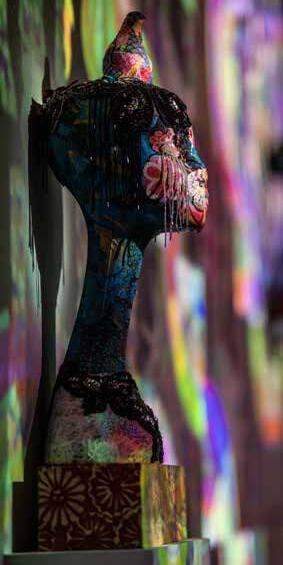
and the Caribbean that have historically been understood within the realm of “folk art,” or arte popular. The artworks range from the quotidian to the spectacular, including toy truck rattles and tiny figurines of food vendors as well as large-scale wedding tapestries and intricate yarn paintings depicting the cosmological forces of nature. Frequently relegated to the categories of “folk,” “naive,” “kitsch,” or artesanía, the artworks in this exhibition defy these limiting labels. All objects are part of donations to the University from two Dallas collecting families in anticipation of the construction of the O’Donnell Athenaeum.
From Texas to the World chronicles the philanthropic and creative spirit of the individuals who have left enduring impressions on both UT Dallas and the Dallas Museum of Art. Focusing on the prominent legacies of the McDermott,
Green, and Jonsson families as well as visionary leaders Bonnie Pitman and the late Dr. Richard Brettell, who all have major ties to both the university and the museum, the exhibition allows the campus and community to experience DMA highlights. Visitors can view masterpieces from Europe, Asia, Africa, the Americas, and beyond, offering a truly global perspective on art and culture. This multi-year partnership allows the North Texas community to experience the DMA’s expansive encyclopedic collection in a new context, a first for many UT Dallas students.
The University’s relationship with the Richardson community is robust and meaningful, extending beyond the city’s borders and strengthening the North Texas region as an ideal place to live, work, and contribute. Year-round access to world-class art exhibitions, performances and place-making for new works await!
Designed by Los Angeles-based firm Morphosis Architects, who also built the Perot Museum of Nature and Science, the O’Donnell Athenaeum will enhance and enrich the arts on the UT Dallas campus. Supported by a major gift from the O’Donnell Foundation, this multi-phase arts and performance complex will ultimately house a 680-seat performance hall and music building opening in the fall of 2026, a dedicated multi-level parking garage, and an additional future museum building.

What is the backstory of Puzzles of Color?
Puzzles of Color was founded in my garage in 2020, driven by a desire to bring more diversity to the puzzle industry. As a family, we’ve enjoyed puzzles since childhood, but we often noticed a lack of imagery that resonated with our own experiences. That’s when we decided to collaborate with artists of color, aiming to offer people vibrant, culturally rich imagery in their puzzles.
What is special about your puzzles?
We wanted to solve the issue of diversity in puzzles while giving people imagery that is worth framing. Our customers get to study beautiful works of art and become the artist themselves as they recreate those images piece by piece. In selecting our art, we have a guiding light of imagery that authentically celebrates a full range of expression for people of color.
How do you go about curating collections and finding artists?
We find artists through a variety of ways including social media,


submissions, and in person networking. Our collections often come together through a common thread of what we are selecting at the time.
What impact do you hope to make on Richardson's arts and culture?
We want to share all of the artists we work with with the community and give people the opportunity to appreciate their work on a deeper level by studying each stroke piece by piece.
Where can we find you?
Contact: www.puzzlesofcolor.com or @PuzzlesofColor on Instagram, FB, TikTok, Twitter, and Threads.




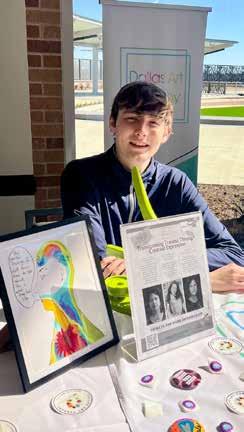
UTD Psychology Student Adam Chapman at the Adolescent Symposium info table for Dallas Art Therapy
Years ago, Dallas Art Therapy founder Andrea Davis attended an art therapy exhibit hosted by the now-closed Art Therapy Institute in Dallas. At that exhibit one piece, a handmade doll with a torn dress carefully mended in each spot, truly stood out to her. Attached to the doll was a letter from its creator, written to her younger self. In the note, the creator promised to care for her inner

child, both then and now, despite past neglect. Witnessing that “mending” of a painful past through art was deeply moving to Davis.
In that moment, Davis knew that, despite having just earned a Master’s degree in humanistic psychology, she had to become an art therapist. In 2017, Davis founded Dallas Art Therapy to make art therapy accessible to anyone in the community who needed
it. A recent interview with Davis shed light on this very special nonprofit organization.
Otte: What is the core mission of Dallas Art Therapy, and how does it guide your work in the community?
Davis: We believe in creating a safe space for individuals to explore difficult emotions without feeling overwhelmed.
By externalizing experiences through art, people can gain new insights and work through layers of emotion at their own pace—an approach that often leads to more sustainable healing, self-discovery, and authentic living. We mentor art therapy master’s students and graduates who are trained to use art and psychology to help clients tap into their creative resources, address real-life challenges, and nurture emotional well-being. This vision drives all our efforts, from forming new partnerships to creating environments where art can be a transformative tool. We also strive to advance the art therapy profession. Currently, we’re supporting Senator Royce West’s SB 1081 and Representative Rafael Anchia’s HB 4557, which both advocate for art therapy licensure. By endorsing these bills, we aim to join the 14 other states that already have licensure, allowing more people to benefit from credentialed art therapy.
Otte: How would you describe the impact of art therapy on individuals' mental and emotional well-being?
Davis: Art therapy offers a holistic way to promote mental and emotional health by merging sensory experiences, cognitive processing, and creative expression. For those who struggle with traditional talk therapy, art provides a nonverbal avenue for exploring complex feelings, developing coping skills, and processing life’s challenges. The creative process itself can be both empowering and revealing; participants often see tangible evidence of their growth through their artwork.
Licensed art therapists play a key role, guiding clients in a safe, supportive environment. They help clients process the artwork, offer emotional support, and foster selfreflection. Through this blend of creativity, professional insight, and selfexploration, art therapy helps reduce anxiety, promotes self-awareness, and cultivates a sense of personal empowerment.

Artwork of eight-year-old boy mentioned in Davis's responses
Otte: What types of individuals or communities typically seek services from Dallas Art Therapy?
Davis: Our clients range from children and teens to adults and seniors, each facing different challenges—trauma, grief, chronic illness, or developmental and behavioral issues. Many come via referrals from schools, community groups like the VA, and other healthcare providers, while others find us through word-of-mouth or our website at dallasarttherapy.org.
Otte: Is there a particular success story or transformation you’ve seen in one of your clients that you can share with our readers?
Davis: One example involves an eight-year-old boy whose drawing skills and academic performance were both below expectations for his age. During art therapy sessions, we offered him a variety of art materials and art directives, which not only helped him explore his
natural creativity but also gave him a nonverbal outlet to process difficult emotions, specifically surrounding family conflict, loss and addiction. Through his artwork, he found a way to externalize the grief of losing a parent, creating a visual narrative that captured the emotional complexity he couldn’t express in words.
Over time, as he gave space for his grief to be seen in art therapy sessions, his drawing skills developed, and his academic performance improved right alongside them. This progress underscores how essential hands-on art-making can be—particularly in a world where children increasingly rely on screens and may miss out on the developmental advantages of drawing or handwriting. By harnessing the tactile and sensory aspects of creativity, art therapy not only helped him process his emotions but also bolstered his coordination, self-esteem, and overall success in the classroom.
Otte: How is Dallas Art Therapy funded?

Davis: We rely on a diverse funding model which combines individual, corporate and community donations; grants from government and private foundations aimed at mental health or arts-based programs; and program fees with a sliding-scale fee for out-ofpocket clients. For those who prefer to use insurance, we share space with Davis Art Therapy & Counseling, an in-network provider for many insurance plans. We also host fundraising events. Initiatives such as the North Texas Giving Day, community projects, and our annual Anita Mester symposium help us raise awareness and support our work.
Otte: What are your ties to Richardson? How do you engage with the community to raise awareness about art therapy and its benefits?
Davis: Richardson holds a special place in our hearts—its diverse, artsrich community aligns with our passion
for creative expression. We’re a proud member of the Richardson Chamber of Commerce and collaborate with school counselors in Richardson ISD, who refer students to us for art therapy services. We also host Workshops, like those with the University of Texas at Dallas (UTD) and Leadership Richardson, alongside our weekly Thursday SOS open studio.
Our current collaboration with the UTD 180 Degrees student team is helping us fine-tune our website and processes for collecting outcome data for art therapy services. In addition, we partner with local mental health professionals and engage UTD psychology student volunteers, ensuring that the healing power of art therapy remains visible and available to the broader Richardson community.
For more information about Dallas Art Therapy, go to dallasarttherapy.org or on Instagram @dallasarttherapy.
• Achieving financial sustainability to offer fulltime salaries and benefits to staff.
• Maintaining sliding-scale and free services, ensuring that finances don’t block access to mental health care.
• Supporting art therapy graduate students in earning licensure and clinical hours to grow local capacity.
• Securing Medicaid coverage once licensure is established so we can serve individuals who rely on these essential benefits.
• Expanding our programs with a larger, more accessible studio.
• Fostering collaborative partnerships to extend our outreach and impact.
Volunteer: Help with events, studio setup, administrative tasks, or outreach.
Donate: Your financial gifts— one-time or recurring—ensure we can continue to offer slidingscale and free services, plus needed supplies.
Attend Events: Participating in our art-focused fundraisers or community projects helps us reach more people in need.
Share Our Work: Follow us on social media @dallasarttherapy and spread the word or invite friends to visit our website at dallasarttherapy.org to learn how art therapy can transform lives.






































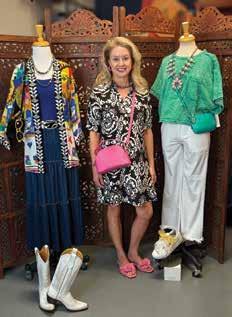





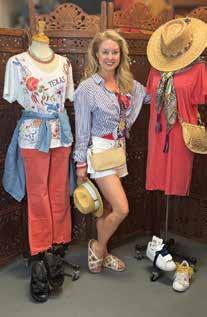












Saturday 8:30 am – 4:00 pm
Richardson Woman’s Club Annual Garden Tour
Visit the beautiful Richardson Woman’s Club for their annual garden tour. Tickets are $25 and a box lunch can be purchased for $10 by April 28. Enjoy coffee and pastries, gift shop and bakeshop in the morning, seminars with garden experts, and a garden tour at various locations. For more information or to purchase tickets and lunch, visit rwctx.org.
Location: Richardson Woman’s Club Estate, 2005 N Cliffe, Richardson
3 - 4
Saturday 10:00 am – 7:00 pm
Sunday 10:00 am – 5:00 pm
Sunday 3:00 pm
Cottonwood Art Festival
From its humble beginnings in 1969, the Cottonwood Art Festival has developed into one of the most prestigious fine art festivals in the United States. This two-day festival is one of Richardson’s most celebrated annual events. The festival is free of charge; however, some activities in the ArtStop children’s area require a nominal fee. For more information, visit cottonwoodartfestival.com.
Location: Cottonwood Park, 1321 W. Beltline Road, Richardson
May the Fourth Be With You
Join the Richardson Community Band as they celebrate the incredible music of the incomparable John Williams during a free concert. Tickets are free and can be claimed ahead of time online at eisemanncenter.com or at the Eisemann Center box office the day of the performance.
Location: Eisemann Center, 2351 Performance Dr, Richardson
Friday 10:30 am – 6:00 pm
Richardson Woman’s Club 18th Annual Golf Tournament
Get your teams together for a good cause! Join other golfers at the RWC annual golf tournament. All funds raised go to local community grants and scholarships. Registration deadline is May 7. For more information, visit rwctx.org.
Location: Sherrill Park Golf Course, 2001 E Lookout Drive, Richardson
16 - 18
Friday 6:00 pm – 11:30 pm
Saturday 12:00 pm – 11:30 pm
Sunday 12:00 pm – 6:00 pm
Wildflower! Arts & Music Festival
Wildflower! Arts & Music Festival, a three-day, award-winning celebration of eclectic arts and music, draws thousands of people annually. Attendees enjoy a variety of musical acts on multiple stages, kids activities in the WF! Kids area, artistic performances, regional cuisine and shopping with local artisans.
Additionally, the festival offers many programs that recognize and support talented musicians and artists such as Battle of the Bands, Budding Talent Vocal Competition, Student Art Contest, and the award-winning Al Johnson Performing Songwriter Contest. There’s also an Art Guitar Auction, featuring acoustic or electric guitars transformed by artists into creative pieces of work available for purchase. The Wildflower! Arts & Music Festival is produced by the City of Richardson Parks and Recreation Department. Visit wildflowerfestival.com for more info.
Location: Galatyn Park Urban Center, Richardson

Does your organization have an event that you’d like to see published in the “Out & About” section of Richardson Life Magazine? If so, please forward the information to pmotte@hylogroup.com. We’d love to share your event with the community!








